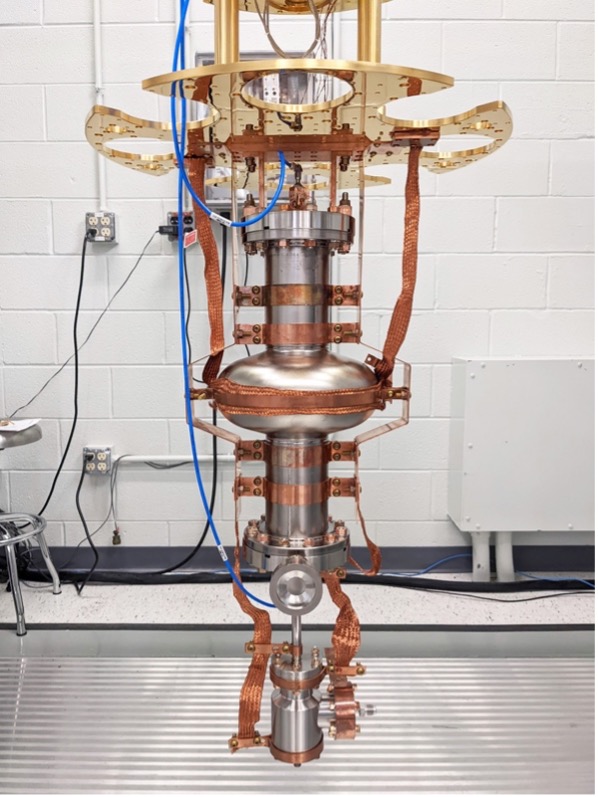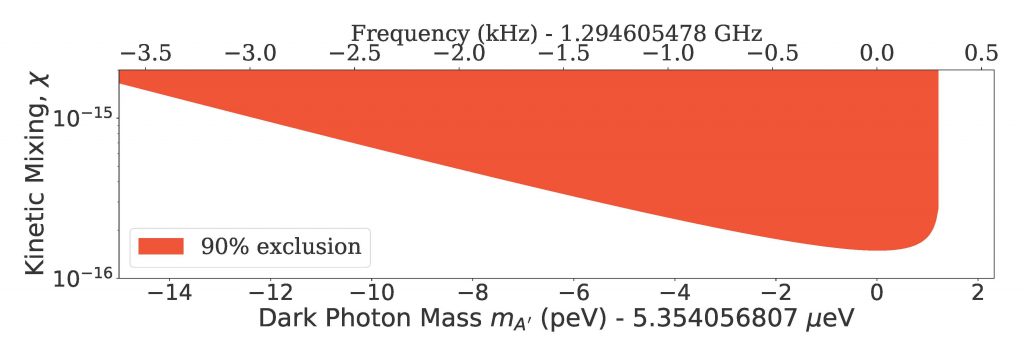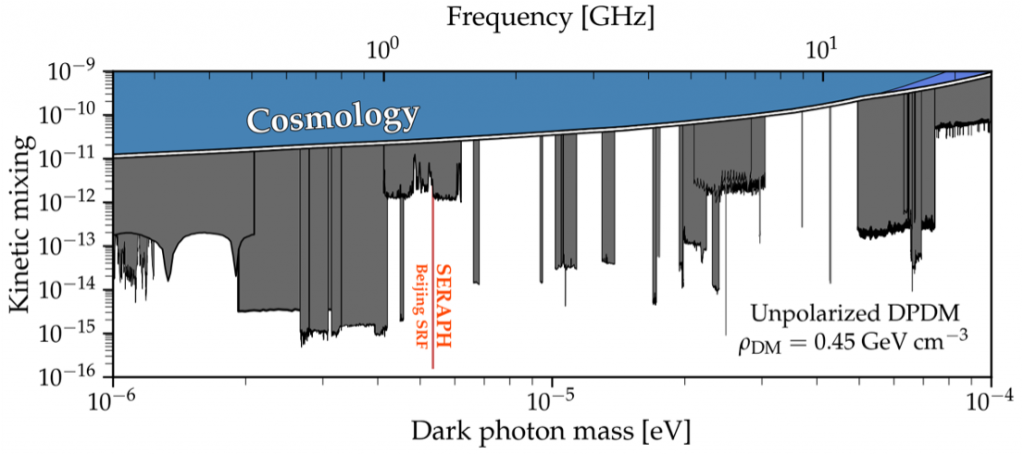Deepest Sensitivity to Wavelike Dark Photon Dark Matter with SRF Cavities
Fermilab’s expertise in superconducting radiofrequency cavities leads to extremely sensitive dark matter detectors, an order of magnitude more sensitive than previous efforts.
The Science:
There is overwhelming evidence that 84.4% of the matter in the universe is made of dark matter (DM). The Lambda Cold Dark Model describes dark matter as feebly interacting, nonrelativistic, and stable on cosmological timescales. Not much else is known about the nature of dark matter, particularly what particles beyond the standard model it is made of.
The dark photon (DP) is a compelling dark matter candidate because it is one of the simplest possible extensions to the Standard Model. If its mass is less than 1 eV, the dark photon dark matter is in the wavelike regime, where it is best described as a coherent wave oscillating at the frequency of its rest mass rather than a collection of particles.
Dark photon dark matter can be detected through its feeble interaction with the Standard Model (SM) photon. This interaction is parametrized through the kinetic mixing strength X. If dark photons convert into SM photons inside a microwave cavity with a large quality factor, then when a feeble EM signal accumulates inside the cavity, it can be read by ultralow noise electronics. This type of detector is called a haloscope and is often deployed to search for axionic DM. The SM photon frequency is related to the dark photon mass (hf = mAc2).



Left: A 90% exclusion on the kinetic mixing strength parameter space. Right: SQMS limits in the context of other microwave cavity haloscopes. Figure adapted from C. O’Hare.
The Impact:
Since the dark photon mass is unknown, haloscopes are ideal for searching through the X vs. mA parameter space. Thus, the scan rate is a crucial figure of merit for haloscope experiments. Most haloscope literature has focused on the case where the cavity quality factor QL is less than the dark matter halo quality factor QL << QDM because copper cavities have traditionally been used. However, superconducting niobium cavities with QL ~ 1010 are readily available for DPDM haloscope searches, and superconducting cavities resistant to multi-Tesla magnetic fields with QL > QDM, consisting of dielectrics, Nb3Sn, or HTS tapes, will soon be readily available axion searches where external magnetic fields are required.
Summary:
This Article first derives that the haloscope scan rate is proportional to QL, even in the case where QL >> QDM and the DP signal power saturates. This conclusion strongly motivates the pursuit of ultrahigh Q haloscopes. This Article then reports a DPDM search using a nontunable 1.3 GHz cavity with QL ~ 1010. The search demonstrates superior sensitivity enabled by the ultrahigh quality factor and achieves the deepest exclusion to wavelike DPDM to date by almost an order of magnitude.
Contact:
Raphael Cervantes – raphaelc@fnal.gov
Focus Area:
Quantum Sensing for Fundamental Physics
Institutions:
Fermi National Accelerator Laboratory, NIST, University di Padova, INFN
Citation:
R. Cervantes, J. Aumentado, C. Braggio, B. Giaccone, D. Frolov, A. Grassellino, R. Harnik, F. Lecocq, O. Melnychuk, R. Pilipenko, S. Posen, and A. Romanenko
Phys. Rev. D 110, 043022 – Published 12 August 2024
https://doi.org/10.1103/PhysRevD.110.043022
Funding Acknowledgement:
This material is based upon work supported by the U.S. Department of Energy, Office of Science, National Quantum Information Science Research Centers, Superconducting Quantum Materials and Systems Center (SQMS) under contract number DE-AC0207CH11359
The authors thank Asher Berlin, Yonatan Kahn, Akash Dixit, and Benjamin Brubaker for fruitful discussions regarding scanning strategies and data analysis with ultrahigh Q cavities. The authors thank Andrew Penhollow and Theodore C. Ill for the cavity assembly.
